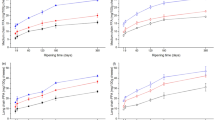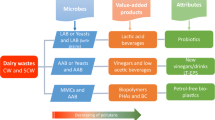Abstract
The aim of the present study was to evaluate the use of kefir culture entrapped in casein and in whey protein as starter cultures for the production of Feta-type cheese. Microbiological analysis showed that counts of enterobacteria, coliforms, and staphylococci were significantly reduced due to kefir culture. In addition, the effect of kefir culture on the formation of volatile compounds, such as esters, organic acids, alcohols, carbonyl compounds, and lactones, was also investigated using the SPME GC/MS technique. Cheese samples produced with kefir culture entrapped in milk proteins presented improved profile of aroma-related compounds. Principal component analysis of the results indicated that the volatile composition of the different cheese types was dependent on the nature of the starter culture. Finally, the sensory evaluation showed that the products produced with kefir culture had a soft, fine taste, and were of improved quality.

Similar content being viewed by others
References
Dimitrellou, D., Kourkoutas, Y., Banat, I. M., Marchant, R., & Koutinas, A. A. (2007). Whey cheese production using freeze-dried kefir culture as a starter. Journal of Applied Microbiology, 103, 1170–1183.
Koutinas, A. A., Bekatorou, A., Katechaki, E., Dimitrellou, D., Kopsahelis, N., Papapostolou, H., Panas, P., Sideris, K., Kallis, M., Bosnea, L. A., Koliopoulos, D., Sotiropoulos, P., Panteli, A., Kourkoutas, Y., Kanellaki, M., & Soupioni, M. (2010). Scale-up of thermally dried kefir production as starter culture for hard-type cheese making: an economic evaluation. Applied Biochemistry and Biotechnology, 160, 1734–1743.
Wszolek, M., Tamime, A. Y., Muirs, D. D., & Barclay, M. N. I. (2001). Properties of kefir made in Scotland and Poland using bovine, caprine and ovine milk with different starter cultures. LWT--Food Science and Technology, 34, 251–261.
Silva, K. R., Rodrigues, S. A., Filho, L. X., & Lima, Á. S. (2009). Antimicrobial activity of broth fermented with kefir grains. Applied Biochemistry and Biotechnology, 152, 316–325.
Cevikbas, A., Yemni, E., Ezzedenn, F. W., Yardimici, T., Cevikbas, U., & Stohs, S. J. (1994). Antitumoural, antibacterial and antifungal activities of kefir and kefir grain. Phytotherapy Research, 8, 78–82.
Rodrigues, K. L., Caputo, L. R. G., Carvalho, J. C. T., Evangelista, J., & Schneedorf, J. M. (2005). Antimicrobial and healing activity of kefir and kefiran extract. International Journal of Antimicrobial Agents , 25, 404–408.
Goncu, A., & Alpkent, Z. (2005). Sensory and chemical properties of white pickled cheese produced using kefir, yoghurt or a commercial cheese culture as a starter. International Dairy Journal, 15, 771–776.
Kourkoutas, Y., Kandylis, P., Panas, P., Dooley, J. S. G., Nigam, P., & Koutinas, A. A. (2006). Evaluation of freeze-dried kefir coculture as starter in Feta-type cheese production. Applied and Environmental Microbiology, 72, 6124–6135.
Dimitrellou, D., Kourkoutas, Y., Koutinas, A. A., & Kanellaki, M. (2009). Thermally-dried immobilized kefir on casein as starter culture in dried whey cheese production. Food Microbiology, 26, 809–820.
Dimitrellou, D., Tsaousi, K., Kourkoutas, Y., Panas, P., Kanellaki, M., & Koutinas, A. A. (2008). Fermentation efficiency of thermally-dried immobilzed kefir on casein as starter culture. Process Biochemistry, 43, 1323–1329.
Fu, N., & Chen, X. D. (2011). Towards a maximal cell survival in convective thermal drying processes. Food Research International, 44, 1127–1149.
AOAC. (1995). Official methods of analysis (16th ed.). Arlington VA: Association of Official Analytical Chemists.
BSI. (1995). Gerber method for the determination of fat in milk and milk products. British Standard 696. London: British Standards Institution.
Kandylis, P., Drouza, C., Bekatorou, A., & Koutinas, A. A. (2010). Scale-up of extremely low temperature fermentations of grape must by wheat supported yeast cells. Bioresource Technology, 101, 7484–7491.
Bianchi, F., Careri, M., Mangia, A., & Musci, M. (2007). Retention indices in the analysis of food aroma volatile compounds in temperature-programmed gas chromatography: database creation and evaluation of precision and robustness. Journal of Separation Science, 30, 563–572.
Abd El-Salam, M. H., Alichanidis, E., Zerfiridis, G. K. (1993). In Cheese: Chemistry, physics and microbiology: Domiati and Feta type cheese (Fox, ed.), Chapman and Hall, London, UK, pp. 301–336.
Moatsou, G., Massouras, T., Kandarakis, I., & Anifantakis, E. (2002). Evolution of proteolysis during the ripening of traditional Feta cheese. Le Lait, 82, 601–611.
Litopoulou-Tzanetaki, E., Tzanetakis, N., & Vafopoulou-Mastrojiannaki, A. (1993). Effect of the type of lactic starter on microbiological, chemical and sensory characteristics of Feta cheese. Food Microbiology, 10, 31–41.
Sarantinopoulos, P., Kalantzopoulos, G., & Tsakalidou, E. (2002). Effect of Enterococcus faecium on microbiological, physicochemical and sensory characteristics of Greek Feta cheese. International Journal of Food Microbiology, 76, 93–105.
Codex Alimentarius (2003). Official Journal of Hellenic Republic, vol. B, article 83, National Printing Office, Athens.
McSweeney, P. L. H., Fox, P. F., Lucey, J. A., Jordan, K. N., & Cogan, T. M. (1993). Contribution of the indigenous microflora to the maturation of Cheddar cheese. International Dairy Journal, 3, 613–634.
Hatzikamari, M., Litopoulou-Tzanetaki, E., & Tzanetakis, N. (1999). Microbiological characteristics of Anevato: a traditional Greek cheese. Journal of Applied Microbiology, 87, 595–601.
Nikolaou, E., Tzanetakis, N., Litopoulou-Tzanetaki, E., & Robinson, R. K. (2002). Changes in the microbiological and chemical characteristics of an artisanal, low-fat cheese made from raw bovine milk during ripening. International Journal of Dairy Technology, 55, 12–17.
Pinho, O., Pintado, A. I. E., Gomes, A. M. P., Pintado, M. M., Malcata, F. X., & Ferreira, M. P. L. V. O. (2004). Interrelationships among microbiological, physicochemical, and biochemical properties of Terrincho cheese, with emphasis on biogenic amines. Journal of Food Protection, 67, 2779–2785.
Gripon, J. C. (1993) Mould-ripened cheeses in cheese: chemistry, physics and microbiology: (Fox, ed.), Chapman and Hall, London, pp. 111–136.
Viljoen, B. C. (2001). The interaction between yeasts and bacteria in dairy environments. International Journal of Food Microbiology, 69, 37–44.
Frank, D. C., Owen, C. M., & Patterson, J. (2004). Solid phase microextraction (SPME) combined with gas-chromatography and olfactometry-mass spectrometry for characterization of cheese aroma compounds. LWT--Food Science and Technology, 37, 139–154.
Molimard, P., & Spinnler, H. E. (1996). Review: compounds involved in the flavor of surface mold-ripened cheeses: origins and properties. Journal of Dairy Science, 79, 169–184.
Curioni, P. M. G., & Bosset, J. O. (2002). Review: key odorants in various cheese types as determined by gas chromatography-olfactometry. International Dairy Journal, 12, 959–984.
Fernandez-Garcia, E. (1996). Use of headspace sampling in the quantitative analysis of artisanal cheese aroma. Journal of Agricultural and Food Chemistry, 44, 1839–1883.
Nogueira, M. C. L., Lubachevsky, G., & Rankin, S. A. (2005). A study of the volatile composition of Minas cheese. LWT--Food Science and Technology, 38, 555–563.
Panseri, S., Giani, I., Mentasti, T., Bellagamba, F., Caprino, F., & Moretti, V. M. (2008). Determination of flavour compounds in a mountain cheese by headspace sorptive extraction-thermal desorption-capillary gas chromatography–mass spectrometry. LWT--Food Science and Technology, 41, 185–192.
Dimitrellou, D., Kandylis, P., Mallouchos, A., Komaitis, M., Koutinas, A. A., & Kourkoutas, Y. (2010). Effect of freeze-dried kefir culture on proteolysis in Feta-type and Whey-cheeses. Food Chemistry, 119, 795–800.
Livney, Y. D. (2010). Milk proteins as vehicles for bioactives. Current Opinion in Colloid and Interface Science, 15, 73–83.
Charteris, W. P., Kelly, P. M., Morelli, L., & Collins, J. K. (1998). Development and application of an in vitro methodology to determine the transit tolerance of potentially probiotic Lactobacillus and Bifidobacterium species in the upper human gastrointestinal tract. Journal of Applied Microbiology, 84, 759–768.
Conflict of Interest
The authors declare that they have no conflict of interest.
Author information
Authors and Affiliations
Corresponding author
Rights and permissions
About this article
Cite this article
Dimitrellou, D., Kandylis, P., Kourkoutas, Y. et al. Cheese Production Using Kefir Culture Entrapped in Milk Proteins. Appl Biochem Biotechnol 176, 213–230 (2015). https://doi.org/10.1007/s12010-015-1568-4
Received:
Accepted:
Published:
Issue Date:
DOI: https://doi.org/10.1007/s12010-015-1568-4




